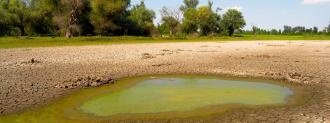In the last two decades, the western U.S. has faced some of the most serious droughts in modern history, largely exacerbated by climate change. It could get worse: historical data shows that North America has been subject to many multi-decade “megadroughts” in the past — and we may be overdue for a big one.
Now, scientists are looking for solutions. One possible defense against a megadrought is a direct form of weather modification, called cloud seeding. Some countries are already pushing ahead with huge cloud seeding programs, but not all scientists are convinced.
How Does Cloud Seeding Work?
The idea of cloud seeding has been around since 1940, when Dr. Vincent J. Schaefer experimented with it for General Electric. But it has seen a recent surge in interest because today’s rising temperatures increase the risk for drought. Some scientists believe that the western U.S. is currently entering a severe megadrought — a 20-year drought that may be the second-worst drought in the last 1,200 years.
In a nutshell, cloud seeding works by scattering special particles high in the air, typically from airplanes, to help clouds condense into rain or snowfall. The particles are typically either dry ice or crushed silver iodide, similar in structure to natural ice.
When the particles enter a cloud, they attract moisture, which gathers together into ice crystals or a raindrop, depending on the temperature.
Cloud seeding occurs naturally when streaks of ice crystals falling from high-level clouds pass into clouds lower in the atmosphere. The ice crystals act as seeds that form larger crystals that ultimately become raindrops.
In theory, this weather modification technique should boost precipitation, alleviating some of the stress from an impending megadrought. Cloud seeding has also been used to dissipate fog, modify hurricanes, or weaken lightning storms — in theory, anyway.
The Chinese government enlisted the Beijing Weather Modification Office to ensure that the 2008 Summer Olympics were rain-free by breaking up clouds and causing them to rain on surrounding areas instead. The Chinese government is now planning a massive expansion of its cloud seeding program in 2025, in an effort to boost rainfall in agricultural areas.
In the U.S., for 44 years, Vail Resorts in Aspen, Colorado, has been seeding clouds to increase snowfall for skiers. They canceled the program this past winter, due to budget cuts from the pandemic.
Some researchers believe weather modification could play an essential role in combating climate-related drought in the western United States.
“Water managers basically have two choices, and both of them are implemented,” Jeff French, an atmospheric scientist at the University of Wyoming told E&E News. “One is to somehow reduce the demand through conservation, and the other is to somehow increase the supply. And cloud seeding is a relatively inexpensive proposition.”
What Are the Negative Effects of Cloud Seeding?
Currently, eight U.S. states are trying cloud seeding, according to E&E News. But the proposition doesn’t come free from controversy. Like any climate change mitigating effort that aims to alter nature, such as genetically modified trees or radiative cooling (a process that reflects heat back to space), weather modification faces resistance.
“Cloud seeding does not create rain; instead, it encourages a cloud on the verge of producing rain to produce more rain than it might otherwise produce,” said Tom Skilling, the chief meteorologist at WGN-TV. “Some atmospheric scientists feel evidence that seeding works is slim. Besides, in a drought, the clouds that produce rain aren’t around to seed in the first place.”.
Many say that cloud seeding isn’t worth the effort. Much of the research shows a 5-20% increase in precipitation. Even so, it isn’t easy to prove that these increases are due entirely to cloud seeding.
Cloud seeding does not create rain; instead, it encourages a cloud on the verge of producing rain to produce more rain than it might otherwise produce.
Tom Skilling
Despite decades of weather modification, estimates about the effects of cloud seeding are ambiguous and hard to pin down. But more recent research says that cloud seeding can generate up to a 35% increase in precipitation, with the strongest studies relying on computer modeling.
“Certainly we’re in a better position now to address that question than we were ten years ago,” Jeff French, an atmospheric scientist at the University of Wyoming, told E&E News. “The state of the science has progressed to the point that it is a question that we can and should be trying to address now.”
Some regions won’t attempt cloud seeding because of fears that it could lead to challenging legal issues if flooding or downwind drought resulted. If a county seeds clouds to produce rain, then the counties downwind (and the farms that rely on rainfall for their livelihood) could miss out on rain had the cloud not been seeded.
Some scientists argue that instead of responding to drought and relying on weather modification techniques, we should be more concerned with the root of the problem — climate change itself.
Despite the pushback, states like Wyoming, Colorado, and Utah aren’t afraid to give it a try. And, faced with a rapidly changing world, we may need all the solutions we can get.
We’d love to hear from you! If you have a comment about this article or if you have a tip for a future Freethink story, please email us at [email protected].






